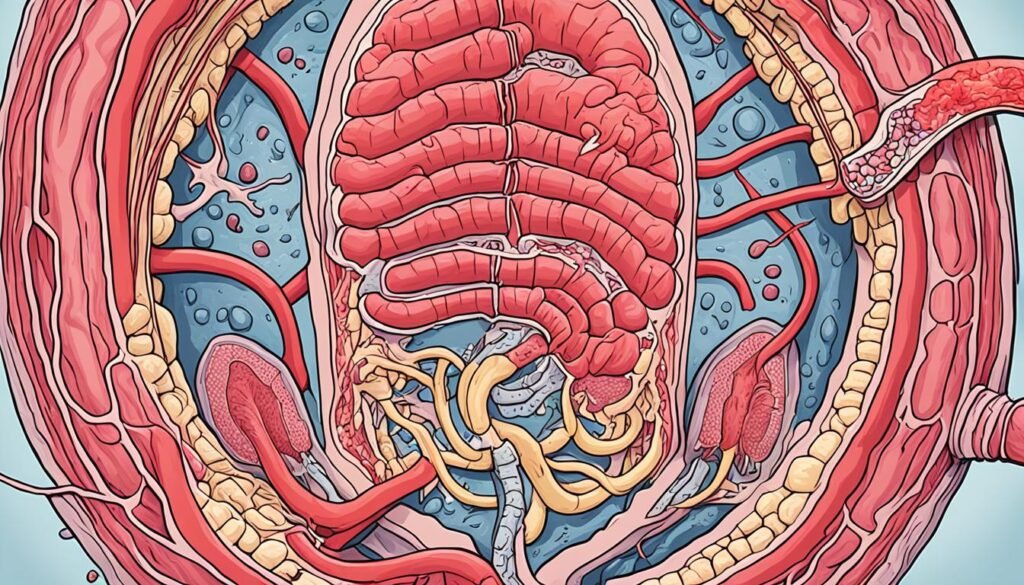|
Getting your Trinity Audio player ready... |
Intussusception is a serious condition where one part of the intestine slides into another part. This causes a block in the intestine. The block stops food or fluid from moving through. It can also stop blood from reaching that part of the intestine.
Table of Contents
ToggleIf not treated, intussusception can cause severe problems. These include infection, tissue death, or the intestine breaking. It’s the top reason for intestinal blockages in kids under 3. Adults can have it too, but it’s usually because of an illness they already have.
Overview of Intussusception
Intussusception happens when one part of the intestine goes into another part. This definition is common, especially in kids. It leads to an intestinal blockage.
Definition and Causes
The main cause of intussusception is often unclear. But, it could be due to something like a polyp or tumor in the intestines. It’s when one part of the intestine moves into the next part, just like a collapsible telescope.
Prevalence and Risk Factors
Intussusception is rare but it’s a top cause of gut blockage in young kids. This is common among 6 months to 3-year-olds. Key risk factors are age, being male, and conditions like cystic fibrosis. Also, Crohn’s disease and Henoch-Schönlein purpura can increase the risk.

Intussusception in Children
Intussusception is more common in babies and young kids, peaking between 6 months and 3 years. If you notice intussusception symptoms in children, quick medical help is important. This issue can become life-threatening fast if it’s not treated.
Symptoms in Infants and Young Children
It usually starts with intense, on-and-off tummy pain making the child cry a lot. If your child is healthy but has this pain, it could be intussusception in children. Other signs to watch for include throwing up, finding blood or jelly-like material in their diaper, and feeling a lump in their tummy.
Potential Causes in Children
The exact reason behind most cases of intussusception causes in children is not clear. But, it could start from a viral infection or something like Meckel’s diverticulum. Kids with certain illnesses, like cystic fibrosis or Crohn’s disease, might be at more risk.
If your child shows intussusception symptoms in children, getting help fast is key. Without treatment, it could damage the intestines, cause serious infections, or worse. Knowing the symptoms and acting quickly can improve your child’s chances of getting better.
Intussusception in Adults
Intussusception is rare in adults, happening in just 2-3 out of 1,000,000 people each year. But, it is a serious issue needing quick medical help. In adults, the symptoms are like those in kids. This includes stomach pain, throwing up, and changes in going to the bathroom. The signs in adults, however, might not be as clear, making diagnosis harder.
In adults, intussusception often happens because of another medical issue. This can be a tumor, scar tissue, or a past surgery on the stomach. So, it can be harder for doctors to figure out and treat.
Many studies shed light on how rare and complex intussusception is for adults. For example, a study published in 1997 by Azar and Berger looked at 160 cases. Weilbaecher et al. checked out 160 adult cases back in 1971. And in 1994, Akcay et al. reported on a case caused by a tumor.
Nagorney, Sarr, and McIlrath also wrote about treating adults with intussusception in 1981. They shared their experiences with over 230 adult cases. Erkan et al. noted in 2005 how tough dealing with adult intussusception is for surgeons. They looked at various cases to reach this point. A study by Tan et al. in 2003 and one by Wang et al. in 2007 also added to our knowledge. They shared their insights and treatments from years of dealing with adult cases of intussusception.
Diagnosing Intussusception
Diagnosing intussusception starts with a detailed physical exam. Your doctor might notice a lump that feels like a sausage in your stomach. This first check helps spot the possible problem and leads to more tests.
Imaging Tests
Next, your doctor will order tests to confirm intussusception. They want to make sure your symptoms aren’t from something else. Tests can include X-rays of your belly and an ultrasound. The ultrasound often shows a pattern that looks like a bulls-eye. This helps confirm the diagnosis.
A contrast enema might be used in some cases. It’s a procedure where a tube with contrast fluid is put in through your bottom. This test can both diagnose and help fix the problem by stretching out the intestine.
These tests are vital for a correct diagnosis of intussusception. They help the healthcare team pinpoint what’s wrong in your belly. With a mix of physical checks and high-tech tests, they can find the best way to help you.
What is Intussusception?
Intussusception is when one part of the intestine slides into another.
It usually happens where the small and large intestines meet.
This folding can block the normal flow of food and fluids.
Telescoping of the Intestine
The sliding or “telescoping” of the intestine can cause a blockage.
This blockage can stop the blood flow, which is very dangerous.
Bowel Obstruction and Blockage
Danger comes when the intestine folds, causing a blockage.
This obstruction can lead to severe problems like tissue death and shock.
Treatment of Intussusception
The first step in treating intussusception often involves an air or contrast enema. This process aims to put the intestine back in its place and get the bowel working as it should. A thin tube is gently put into the rectum. Then, air or a special fluid is slowly put in to move the intestine back.
Air or Contrast Enema Reduction
About 90% of child cases see success with an air or contrast enema. If this happens, the child can leave the hospital soon after, once doctors make sure they are okay. But, in 10-15% of cases, this method won’t work. Then, a surgery is needed to fix the problem.
Surgical Intervention
If the enema doesn’t work, or if there is a tear in the intestine, surgery might be the next step. Surgeons will try to push back the part that is sticking out. Or, they might have to cut away a small piece of the intestine. This type of surgery is most common in adults or very sick individuals with intussusception.
It’s very rare, but intussusception can sometimes go back to normal without any treatment. Still, getting medical help right away is very important. This is to prevent severe dehydration, shock, or dangerous infections if left untreated.

Complications of Untreated Intussusception
Intussusception, if left untreated, can create serious issues. The telescoped intestine can block its own blood flow. This leads to intestinal ischemia and necrosis (tissue death). A tear in the intestine might then let gut contents leak into the body’s cavity, causing a bad infection. This is known as peritonitis. If not treated fast, sepsis and shock may follow, both needing urgent care.
Intestinal Ischemia and Necrosis
Obstruction in the intestine can stop blood flow, causing intestinal ischemia and necrosis or tissue death. If not fixed, the intestine can tear, letting its contents flow out. This leads to a bad infection in the body’s cavity.
Peritonitis and Shock
Intestinal leaks can cause a very serious infection called peritonitis. Peritonitis can lead to sepsis, which is a health crisis. It can make organs fail and cause serious problems in the body. Fast care is vital to avoid these severe issues.

Recovery and Post-Treatment Monitoring
After Enema Reduction
If your child’s intussusception is fixed with an enema, they’ll need some hospital time. Here, they are watched to make sure everything is alright. They might have a bit of pain or a low-grade fever. But, these things can be taken care of with medicine.
After they start feeling and eating better, they can go home. The recovery at home will continue.
After Surgical Reduction
In some cases, surgery is needed if the enema doesn’t work. This makes the recovery a bit longer. First, your child will stay in a special hospital area. Here, their health will be watched closely as they recover.
Then, they will move to a regular hospital room. They need to wait for the surgery cut to heal. Your child might feel pain, have a slight fever, or other symptoms. But the doctors will help manage these.
It’s vital to have check-up visits with the surgeon. This is to complete the recovery from surgery. Also, it makes sure any problems are addressed.
Intussusception and Rotavirus Vaccine
The rotavirus vaccine has been linked to a slight risk of intussusception in babies. This vaccine protects young kids from serious diarrhea and vomiting caused by the rotavirus disease. Yet, studies suggest there’s a small chance of intussusception within a week of the first or second dose.
The chances are very low, but doctors watch for this carefully. They consider the benefits of the vaccine against this slight risk when advising parents about the immunization.
More facts, about 600,000 to 800,000 children under five years die each year from rotavirus. There have been trials in the USA and Finland, and findings were positive. The vaccine was effective in reducing rotavirus infections significantly.
However, after nine cases of intussusception following the rotavirus vaccine in the USA, they paused the program. This was found among about 1.5 million doses given out.
After looking back at cases, a study found a strong link between the vaccine and intussusception in healthy babies. The research shows that within 3 to 14 days, there was a higher risk after getting the vaccine. The odds were significantly related to the vaccine, meaning it could have caused intussusception in some infants.
This points to a need for a safer rotavirus vaccine. The pause in using the current vaccine could also slow down making new ones. It’s key to have a reliable and safe vaccine for rotavirus, especially in countries where it causes a lot of deaths.
When to Seek Medical Attention
Intussusception needs quick medical help. If not treated fast, it can lead to dangerous issues. Parents should act right away if their child has strong stomach pain. They should also look for vomiting, bloody stools, or a hard area in the belly. These signs could mean intussusception and need a doctor’s check right now.
Recognizing Emergency Signs
If a child is very tired, in shock, or has other bad signs, get help immediately. These might show that the situation is getting worse. It’s important to know when to see a doctor and to act fast in an emergency.
Preventing Intussusception
There’s no sure way to prevent intussusception because we don’t fully know its causes in many cases. But making sure your kids get the rotavirus vaccine is a big step. This vaccine might slightly raise the chance of intussusception in the first week.
It’s also important to keep your child’s digestive system healthy. This involves eating well and staying hydrated. If you notice any tummy troubles, getting medical help quickly is crucial.
Being proactive about your child’s health matters a lot. Knowing the signs of intussusception can help. Early symptoms like severe stomach pain are important to watch for. Getting help quickly can prevent serious problems.
Remember, fast action is key at the first sign of intussusception. Early treatment can really make a difference. With more research, we hope to learn more about preventing this condition.
Conclusion
Intussusception is a serious intestinal problem needing quick medical attention. This issue happens when one part of the intestine slides into another. It can block the bowel and is most common among children, but adults can get it too.
Spotting symptoms early is key. Such signs include sudden stomach pain, throwing up, and blood or jelly-like poop. Without treatment, intussusception can lead to severe problems, such as the bowel breaking or an infection. Doctors use an enema or sometimes need to do surgery. Afterward, regular check-ups are crucial for recovery.
The exact causes of intussusception often aren’t clear. But knowing the symptoms and risks can guide quick and correct medical care. Learning about this condition and its treatments is important. It helps ensure a better outcome for those dealing with intussusception.
FAQ
What is intussusception?
Intussusception happens when one part of the intestine slides into another part. It blocks the flow of food or liquid and may cut off the blood supply.
What are the symptoms of intussusception?
Kids with intussusception often have sharp stomach pain. This makes them very upset and they cry a lot. Signs may also include throwing up, seeing blood in the stool, or feeling a hard lump in the belly.
How is intussusception treated?
Doctors first try to fix it without surgery. They might use a special enema to push the intestine back in place. If this doesn’t work, surgery is needed.
What are the complications of untreated intussusception?
Not fixing intussusception can cause severe harm. It might damage the intestine, lead to infection, or even be deadly.
How does the rotavirus vaccine affect intussusception?
The rotavirus vaccine might slightly raise the risk for a week after getting it. But, this risk is very low. Doctors believe the vaccine’s benefits are greater than this small risk.
When should I seek medical attention for intussusception?
If your child feels sudden and strong stomach pain along with other signs, get medical help right away. This could be intussusception and needs quick treatment.
Source Links
- https://www.mayoclinic.org/diseases-conditions/intussusception/symptoms-causes/syc-20351452
- https://www.chop.edu/conditions-diseases/intussusception
- https://www.niddk.nih.gov/health-information/digestive-diseases/anatomic-problems-lower-gi-tract/intussusception
- https://www.ncbi.nlm.nih.gov/books/NBK431078/
- https://www.ncbi.nlm.nih.gov/books/NBK545264/
- https://www.ncbi.nlm.nih.gov/pmc/articles/PMC2653360/
- https://www.ncbi.nlm.nih.gov/pmc/articles/PMC5179276/
- https://www.mayoclinic.org/diseases-conditions/intussusception/diagnosis-treatment/drc-20351457
- https://www.ncbi.nlm.nih.gov/pmc/articles/PMC1773072/
- https://emedicine.medscape.com/article/930708-overview
- https://www.ncbi.nlm.nih.gov/pmc/articles/PMC2780199/
- https://www.uptodate.com/contents/intussusception-in-children


